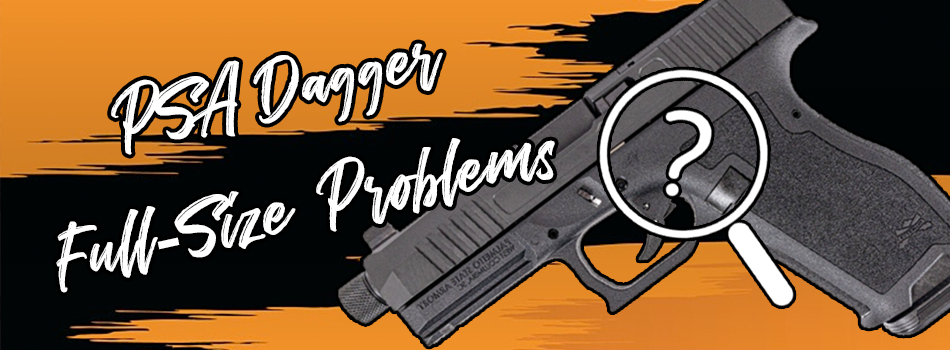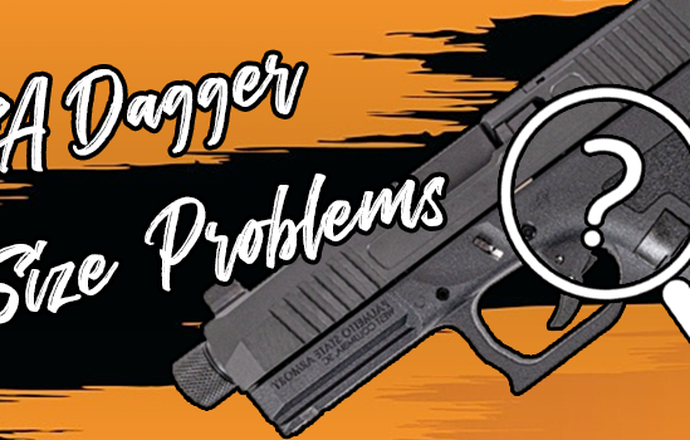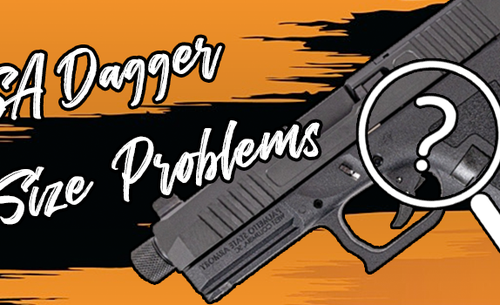


Whenever I hear about any new budget-minded firearm, my first thought is often: “That’s great, but what’s wrong with it?” Getting good value for my money is important, but I place more importance on owning a weapon that I can trust to perform when it counts. So that begs the question: What are the PSA Dagger problems, and are there any solutions to them?
PSA DAGGER OVERVIEW
As a firearms enthusiast, I've always been intrigued by the ever-evolving landscape of handguns. Among the new entrants, the PSA Dagger caught my attention with its promise of being an affordable alternative to the well-established Gen 3 Glock.
First, let’s take a quick look at how the hardware shapes up.
- Model Name: Palmetto State Armory Dagger Full Size - S
- Caliber: 9mm
- Action: Striker-fired
- Weight (uloaded): 22.5 oz
- Capacity: 17+1
- Overall Width: 1.28"
- Overall Length: 7.15"
- Overall Height: 5.38" (w/o mag inserted)
- Barrel Length: 4.5"
- Barrel Material: Stainless Steel
- Barrel Finish: DLC Coating
- Slide Material: Stainless Steel
- Slide Finish: Black DLC Coating
- Twist Rate: SAAMI Spec 1:10
- Frame Material: Polymer
- Safety: Striker Block Safety & Trigger Safety
- Optics Mount: RMR Pattern
- MSRP: Starts at $299
PSA DAGGER FEATURES
Just like outlined in our recent PSA Dagger Review, this versatile and reliable 9mm handgun seamlessly combines performance and ergonomics. With its 9x19mm chamber, this pistol comes equipped with a PMAG® 17 GL9™ (17-round) magazine, ensuring ample capacity for various shooting scenarios.
The single-action striker-fired trigger delivers a smooth, crisp, and consistent pull, enhancing accuracy and user-friendly operation.
PSA Dagger Full Size S Model
The Dagger Full Size S model combines the comfort of a full-size frame with the convenience of a compact slide, resulting in improved handling and compatibility with a range of accessories. This versatile pistol offers various slide and barrel configurations, like the Extreme Carry Cut RMR Slide and Threaded Barrel, allowing shooters to customize it according to their preferences.
Moreover, the firearm offers different finish options, including Black DLC, Sniper Green, and Chameleon, for a personalized touch. Overall, the PSA Dagger Full Size is a reliable and adaptable handgun that caters to a wide array of shooting needs and individual preferences.
Features vs problems
For the rest of this article, I’ll lay out all the PSA Dagger issues I came across during my testing or research and give you my best workarounds or solutions for each problem.
Second, I’ll go over some of the most common FAQs when it comes to PSA Dagger problems.
Let’s take a look.
TOP 5 PSA Dagger Problems
Here's a quick summary of the most urgent PSA Dagger issues. I'll take you through each and every one of them, but most importantly, I'll show you how to fix PSA Dagger problems without too much effort.
- Trigger quality and performance issues
- Grip texture concerns
- Inconsistent reliability, especially with certain magazines
- Compatibility issues with Glock holsters
- Slide serration design potential for malfunctions
Problem #1 - PSA Dagger Trigger Quality and Performance Issues
In my personal experience with the PSA Dagger, the trigger quality and performance have been a mixed bag. Upon initial use, I noticed some minor differences compared to other handguns I'm accustomed to—namely, the trigger pull feeling gritty and having multiple stages before the break.
It wasn't the smooth, crisp trigger I was used to, but it also wasn't a deal-breaker for me.
Over time, as I put more rounds through the pistol, I did notice an improvement in the trigger's overall feel. The grittiness seemed to diminish, and the trigger pull became more consistent and predictable.
Any gun review has to acknowledge that trigger preferences are going to vary greatly among shooters. While I didn't encounter significant issues with the trigger, I can understand how some users might find its characteristics less appealing, especially those who are accustomed to well-used Glocks with smoother triggers.
Working Around Trigger Issues
For those who find the trigger quality and performance of the PSA Dagger less than ideal, there are a few ways to work around or potentially improve the situation. The best approach, I believe, is to simply put more rounds through the pistol. In my own experience, the trigger quality will likely improve over time, diminishing the grittiness and conditioning yourself to the stages of pulling.Additionally, consider that aftermarket parts often play a role in improving trigger performance - so explore options for trigger upgrades or replacements. Some shooters choose to install aftermarket triggers to achieve a smoother and more refined trigger pull.However (since this is a nationally-focused blog), I should say that mods should be approached cautiously, as modifying critical components of a firearm can have legal and safety implications.
Problem #2 - PSA Dagger Grip Texture Concerns
In terms of grip texture, I’d say the PSA Dagger designers strove for a balance between providing adequate traction and ensuring shooter comfort - but what they ended up with is an unusually aggressive one. Grip is always particularly important for those who intend to carry the pistol concealed, as excessive grip texture can lead to discomfort during extended periods of wear.
From my own experience, the grip texture of the PSA Dagger struck a good balance. It provides the necessary friction to prevent slipping, even in adverse conditions or during rapid firing, while still allowing for comfortable handling. I found the texture didn't cross that line when it feels like it's chewing into my skin or clothes, which can be an issue with some handguns featuring even more aggressive grip patterns.
Managing Grip Texture Concerns
For individuals who find the grip texture of the PSA Dagger too aggressive for their liking, there are potential solutions. The most common approach is to apply grip tape or decals to the handgun's frame - allowing shooters to customize the grip texture to their preference, adding or subtracting traction as needed.
A simpler solution to consider is wearing gloves while shooting. I live in a cold climate, where gloves are a frequent necessity regardless of what firearm I choose. Specific shooting gloves often provide an additional layer of comfort and protection, minimizing the potential discomfort caused by an aggressive grip texture.
Keep in mind that while gloves can help address grip texture concerns, they may also impact the tactile sensitivity and feel of the trigger.
Problem #3 - PSA Dagger Inconsistent Reliability, Especially with Certain Magazines
One area that emerged as a notable concern during my research with the PSA Dagger was problems when using certain magazines. While the Dagger’s overall build and design definitely has the potential to offer a reliable shooting experience, there were also a few instances of malfunctions that I felt should be looked into.
Magazine-Related Reliability Challenges
The PSA Dagger's reliability issues seemed particularly tied to the magazines used. My resources highlighted that while the firearm showed promise during the initial shooting sessions, malfunctions became apparent as the round count increased.
Specifically, there were instances of failure to feed malfunctions, which can disrupt the shooting experience and potentially compromise the handgun's effectiveness for defensive use.
These malfunctions were observed more frequently when using certain aftermarket magazines, such as Magpul PMAGs, as opposed to standard Glock magazines. For those who rely on aftermarket magazines for cost savings or other reasons, this inconsistency in reliability with certain options can be a notable drawback.
Addressing Reliability Concerns
Prioritize the use of standard Glock magazines, which most professionals seem to agree offer a more consistent and reliable shooting experience. Glock magazines also have the advantage of being widely available and with a reputation for reliability, making them a suitable choice for those seeking dependable performance.
What if you are particularly attached to a specific aftermarket magazine? I’d recommend thoroughly testing the combination before relying on it for critical applications. Conducting extensive testing with different types of ammunition and shooting conditions always seems to provide me insight into how the pistol performs with my chosen magazines.
Regularly maintaining the firearm and magazines and ensuring they are clean and well-lubricated can contribute to smoother feeding and cycling.
Problem #4 - Compatibility of PSA Dagger with Glock Holsters
It still amazes me when other shooters fail to realize why holster compatibility is such a critical factor for handgun security. Regardless of what kind of Glock clone you might consider using - the PSA Dagger or otherwise - minute design variations and deviations from the standard Glock platform have the potential to severely impede its functionality and reliability.
Holster Compatibility Challenges
Simply put - the PSA Dagger does not seamlessly fit into all Glock holsters. Compatibility issues could be attributed to differences in slide serrations, grip texturing, and other design elements that set the PSA Dagger apart from standard Glock models.
The fact that the PSA Dagger does not directly replace Glock models in existing holsters may inconvenience users who already own Glock-compatible holsters or who prefer to use proven holster designs. This becomes especially relevant for those who prioritize consistency in their gear and training, as transitioning between different holsters can impact muscle memory and draw efficiency.
Working Around Compatibility Concerns
Explore holsters specifically designed for the PSA Dagger through holster manufacturers who develop models tailored to its unique specifications. Investing in a dedicated PSA Dagger holster designed for the definitive specs of the Dagger can ensure a snug fit and optimal retention.
Problem #5 - PSA Dagger Slide Serration Design Potential for Malfunctions
The PSA Dagger introduces an interesting twist to the familiar Glock design with its distinctive slide serrations - both front and rear. Slide serrations are primarily intended to aid in slide manipulation, but the design of these serrations on the PSA Dagger has raised concerns regarding their potential impact on firearm functionality and reliability.
Some reviewers and users I’ve come across have highlighted potential downsides associated with this design feature.
Potential for Malfunctions
The resources I’ve reviewed suggest that the slide serrations on the PSA Dagger might contribute to certain malfunctions, particularly in scenarios where debris or foreign objects can enter the slide area. The added surface area and complexity of the serrations could potentially create spaces where dirt, sand, or other debris could accumulate, affecting the smooth cycling of the slide.
This, in turn, may result in malfunctions, such as failures to fully cycle, failures to extract, or failures to eject spent casings.While this concern may not be a widespread issue, it highlights the importance of understanding how design choices can impact the practical functionality of a firearm. It's worth noting that malfunctions due to debris infiltration can occur with any firearm, but the design of the PSA Dagger's slide serrations may potentially exacerbate this issue.
Mitigating the Risk
Steps can be taken to mitigate the potential risks associated with the slide serration design. Regular firearm maintenance, including routine cleaning and inspection of the slide area, can help prevent the buildup of debris that may lead to malfunctions. Additionally, selecting an appropriate PSA Dagger holster or protective cover when carrying the firearm can help shield the slide from foreign objects and minimize the likelihood of debris infiltration.
PSA Dagger Problems FAQ section
Many users have reported that the initial trigger pull on the PSA Dagger feels gritty, and the trigger has multiple stages with a noticeable wall before firing. However, many users have indicated that the trigger quality improves after a significant number of rounds.
There are reports of the PSA Dagger showing inconsistent reliability during some testing rounds, specifically failure to feed malfunctions with certain magazines. Most users we’ve reviewed experienced no issues with Glock OEM magazines. There have been reports of malfunctions when using aftermarket magazines like Magpul PMAGs.
Overall, users have reported satisfactory performance with most ammunition brands. Cheaper ammunition choices may impact any pistol's overall reliability.
The PSA Dagger is not compatible with Glock holsters due to its slightly different dimensions. While this may not be a major concern for some users, it can be inconvenient for those who already own Glock-compatible holsters and accessories. As a general rule, it’s always a good idea to pair a specifically tailored holster with your carry weapon of choice, regardless of the make or model.
The grip texture of the PSA Dagger has been a point of contention. While some appreciate its ‘grippiness,’ others find it too aggressive - enough to cause discomfort during extended shooting sessions.
Reports of reliability issues with the PSA Dagger seem to vary quite a bit. While a few individuals say they have experienced frequent malfunctions, most others have reported relatively trouble-free operation. It's always important to note that individual experiences may differ.
The PSA Dagger is compatible with Glock magazines - a very positive feature. However, the pistol's reliability when using certain aftermarket magazines has raised concerns, particularly when it comes to feeding issues.
Conclusion - The bottom line to PSA DAGGER ISSUES
Whether it’s a Glock clone or an original and maybe innovative design, no new contender on the firearms market is going to be flawless. And the PSA Dagger is no exception.
From trigger quirks to grip texture debates and magazine compatibility hiccups, it's easy to get caught up in the intricacies, personal preferences, or minute details of a gun.
However, at the core of all these criticisms, my personal conclusion is that this handgun manages to provide an affordable option without sacrificing its fundamental functionality.
Embracing the PSA Dagger means understanding its nuances and working around them. Despite its imperfections, the PSA Dagger merits consideration - a tool that, with practice and understanding, can confidently serve its purpose in ensuring personal safety.
Pair it with the right PSA Dagger holster, and you’ve got yourself a winning combination.
Solutions to PSA DAGGER PROBLEMs
1. Trigger quality and performance issues - Employ a strenuous break-in period or replace the trigger.
2. Grip texture concerns - Shooting gloves are the simplest solution, followed by grip tape or decals.
3. Inconsistent reliability, especially with certain magazines - Stick with brand name PSA or Glock mags
4. Compatibility issues with Glock holsters - Always choose a model-specific holster for your firearm.
5. Slide serration design potential for malfunctions - Regular maintenance including routine cleaning and inspection of the slide area along with a form-fitting holster can reduce the odds of grit and debris issues.
